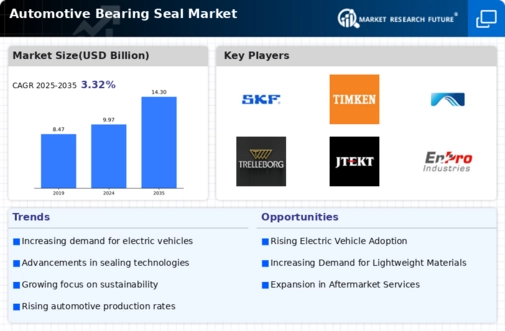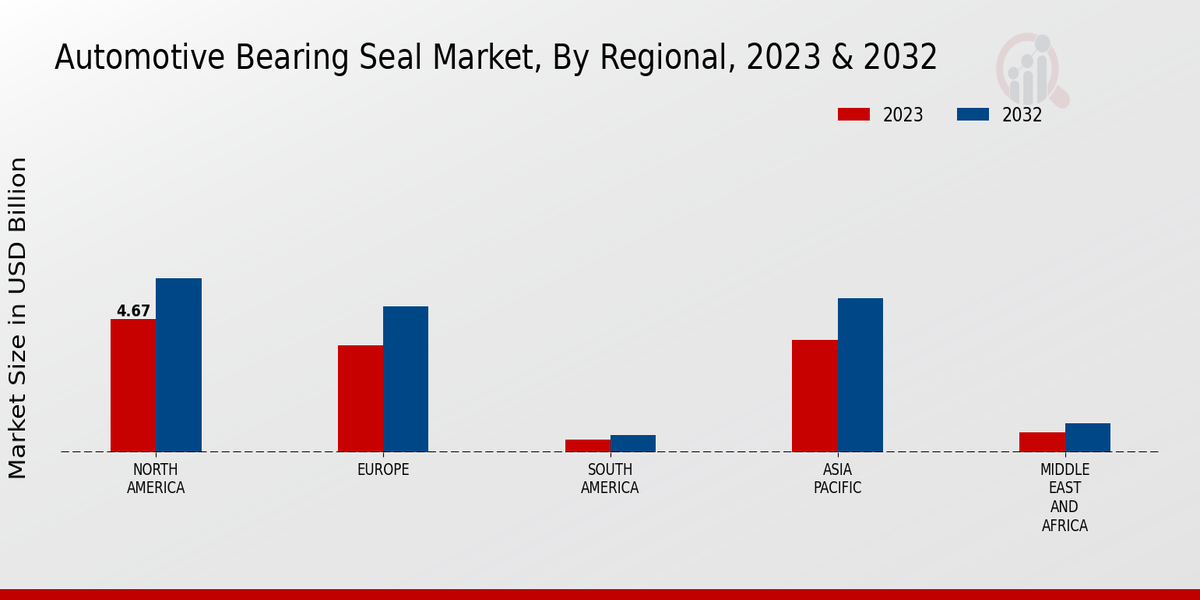Market Growth Projections
The Global Automotive Bearing Seal Market Industry is projected to experience substantial growth over the next decade. With a market value of 9.97 USD Billion in 2024, it is expected to reach 14.3 USD Billion by 2035, indicating a robust trajectory. The compound annual growth rate (CAGR) of 3.32% from 2025 to 2035 suggests a steady increase in demand driven by various factors, including technological advancements and rising vehicle production. This growth is indicative of the industry's resilience and adaptability in meeting the evolving needs of the automotive sector, positioning it favorably for future developments.
Expansion of Aftermarket Services
The expansion of aftermarket services is emerging as a significant driver for the Global Automotive Bearing Seal Market Industry. As vehicle ownership rates rise, the need for maintenance and replacement parts, including bearing seals, becomes increasingly critical. This trend is particularly evident in regions with a growing vehicle population, where aftermarket services play a vital role in ensuring vehicle longevity and performance. The anticipated growth to 14.3 USD Billion by 2035 reflects the potential of this segment. Additionally, the increasing awareness among consumers regarding the importance of quality replacement parts may further stimulate demand for high-performance bearing seals in the aftermarket.
Rising Vehicle Production and Sales
The resurgence in vehicle production and sales globally is a crucial driver for the Global Automotive Bearing Seal Market Industry. As economies recover and consumer confidence grows, the automotive sector witnesses an uptick in manufacturing activities. This increase in vehicle output necessitates a corresponding rise in the demand for bearing seals, which are integral components in various automotive applications. The projected market growth to 9.97 USD Billion in 2024 underscores this trend. Furthermore, as manufacturers strive for higher quality and performance, the demand for advanced sealing solutions is likely to escalate, further propelling market growth.
Growing Demand for Electric Vehicles
The increasing adoption of electric vehicles (EVs) is a pivotal driver for the Global Automotive Bearing Seal Market Industry. As automakers transition towards electrification, the need for specialized bearing seals that can withstand higher temperatures and provide enhanced sealing capabilities becomes paramount. In 2024, the market is projected to reach 9.97 USD Billion, reflecting the industry's response to this shift. EVs often require more advanced sealing solutions due to their unique operational characteristics, which may lead to a surge in demand for innovative bearing seals. This trend is likely to continue as the global automotive landscape evolves, potentially driving the market further.
Regulatory Standards and Environmental Concerns
Increasing regulatory standards and growing environmental concerns are driving the Global Automotive Bearing Seal Market Industry towards more sustainable practices. Governments worldwide are implementing stricter regulations regarding emissions and vehicle efficiency, prompting manufacturers to adopt advanced sealing solutions that reduce friction and enhance performance. This shift towards sustainability is likely to foster innovation in seal design and materials, aligning with global efforts to minimize environmental impact. As a result, the market may experience a compound annual growth rate (CAGR) of 3.32% from 2025 to 2035, reflecting the industry's adaptation to these regulatory pressures.
Technological Advancements in Seal Manufacturing
Technological innovations in seal manufacturing processes are significantly influencing the Global Automotive Bearing Seal Market Industry. Advanced materials and production techniques enhance the durability and performance of bearing seals, catering to the evolving needs of modern vehicles. For instance, the introduction of polymer-based seals offers improved resistance to wear and temperature fluctuations. As manufacturers invest in research and development, the market is expected to grow, with projections indicating a rise to 14.3 USD Billion by 2035. These advancements not only improve product longevity but also contribute to overall vehicle efficiency, thereby attracting more consumers and manufacturers alike.





















